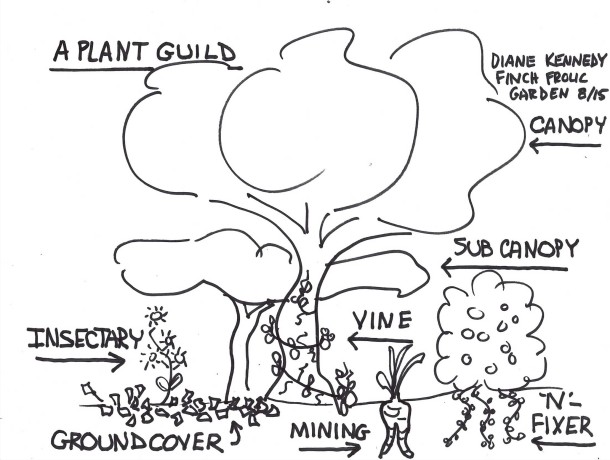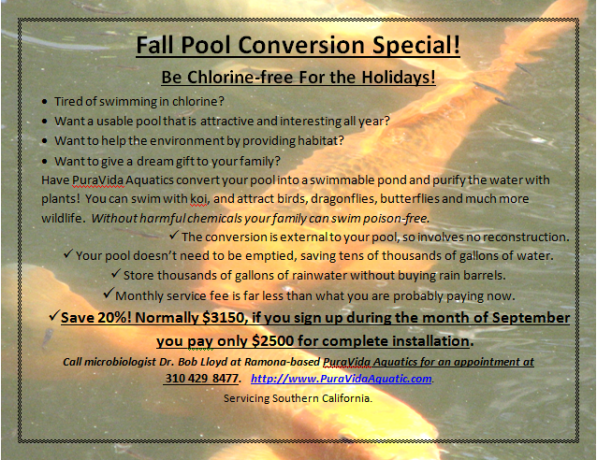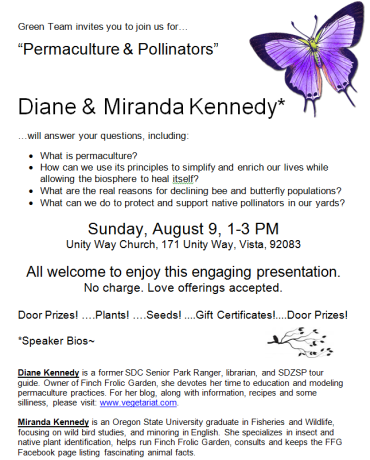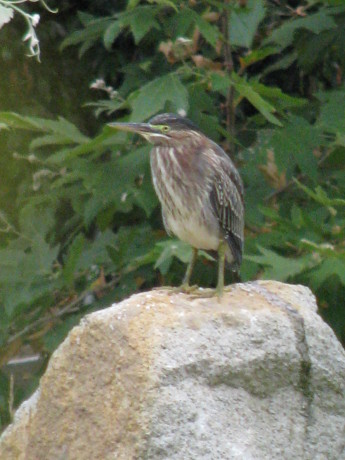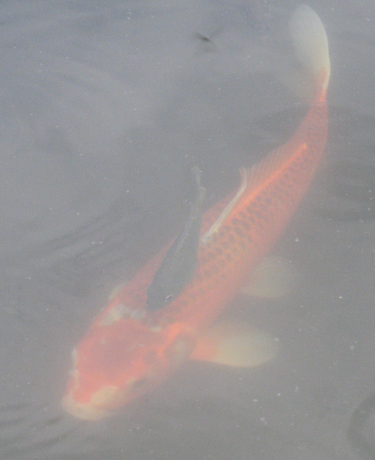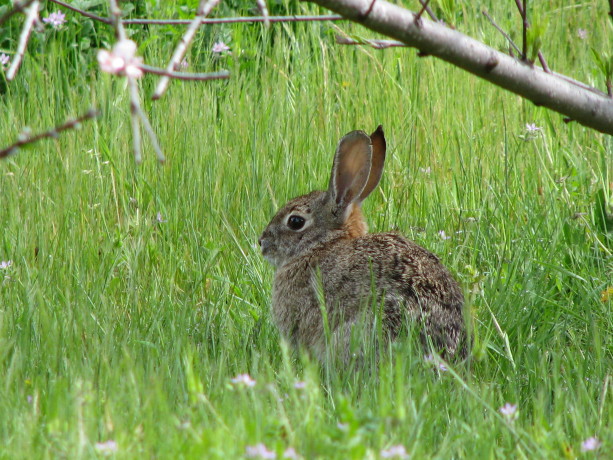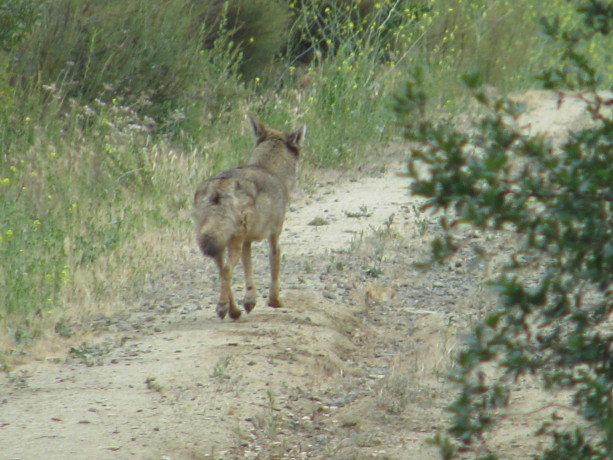Quail
- Animals, Birding, Gardening adventures, Integrated Pest Management, Natives, Planting, Quail, Water Saving
Native Plant List for Birds
Photo by Miranda Kennedy
Today Miranda and I (mostly Miranda!) spoke about native San Diego plants that were best for birds. Miranda’s excellent bird photography and her in depth knowledge of wildlife behavior made our talk for the Audubon San Diego Bird Conference very informative. She is always fun to speak with, too. We presented a slide at the end that listed plants that were featured in the presentation and I promised to post it here. By no means is this an exhaustive list; birds will take advantage of any resources they can to survive. However these plants can be purchased and planted in landscapes (we notably left off the poison oak in the above photo, which is a excellent food and habitat plant, especially for towhees who prefer to nest in it!). And here it is:
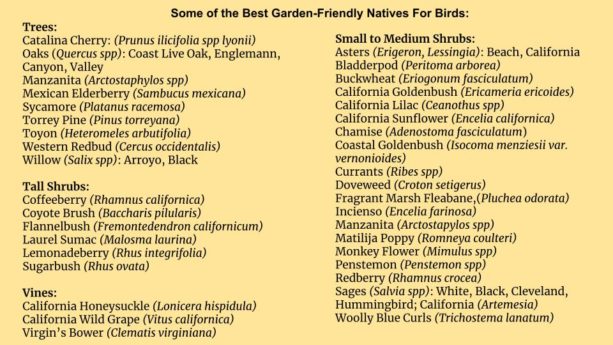
- Animals, Bees, Integrated Pest Management, Natives, Other Insects, Permaculture and Edible Forest Gardening Adventures, Predators, Quail, Reptiles and Amphibians
Native Insects and IPM

A tiny wasp. Honeybees are not native to North America; however, we have an amazing number of underappreciated, ignored or sprayed native insects. Here in Southern California where the lack of rainfall has created a landscape called the Elfin Forest, the canopy is short, the animals are small and many of the insects are very tiny. If you take a careful look at clusters of small blossoms you will see tremendous air traffic. Besides the honeybees, there are butterflies, moths, and bees, wasps and flies that range in size from the large black carpenter bees and shiny green June bugs, to predatory wasps no larger than a speck of dirt on the back of your hand. These are your companions. They are the unsung workers responsible for a large percentage of pollination and invasive insect control. They in turn are food for the other policing creatures of your garden, the small birds, lizards, frogs and toads. And newts, salamanders, dragonflies and damselflies… I don’t want to leave any of these marvelous workers out.
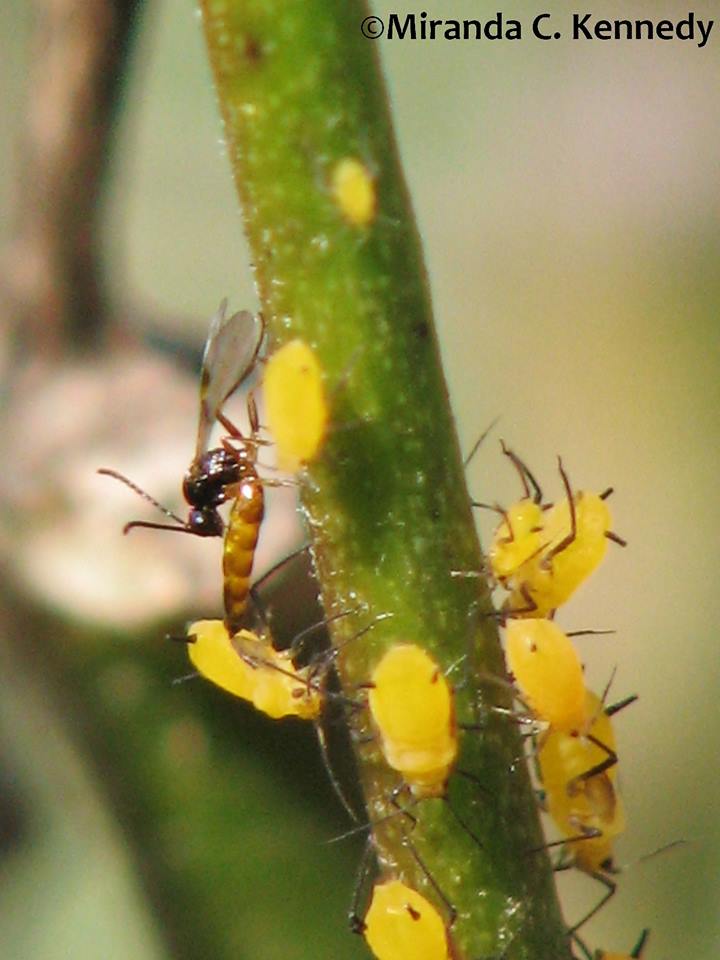
A native predatory wasp laying eggs in oleander aphids on milkweed. These tiny insects need small clusters of flowers to feed upon, and planting to cater to the native insect population wherever you live is vitally important. It is just as important as building good microbial communities in the soil.
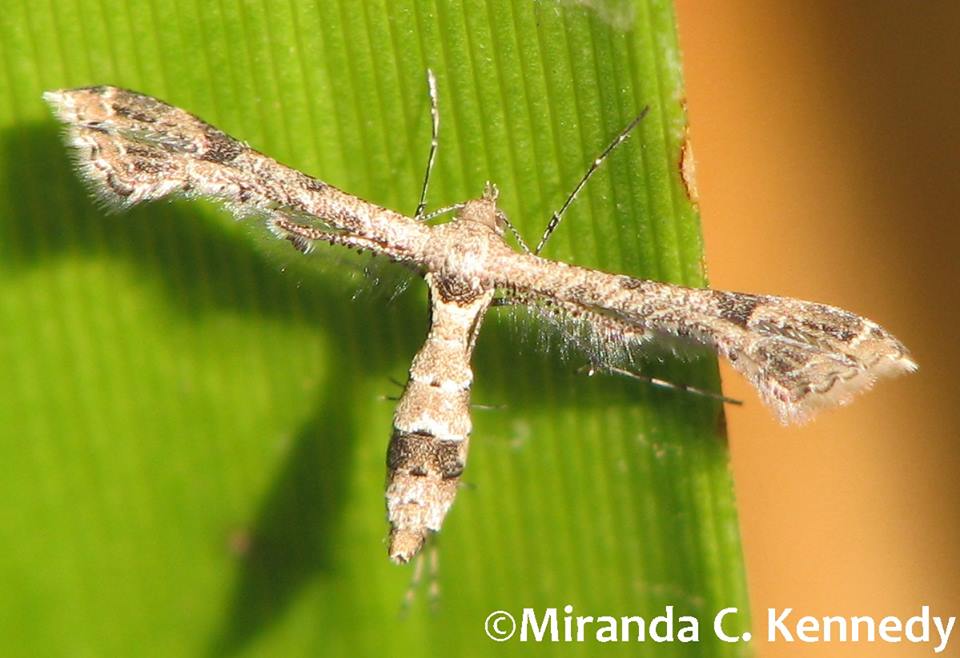
A plume moth. Here is a video – a shaky one taken with my phone as my camera is in for repair – of the tremendous activity around our blooming apple mint. The mint is next to our vegetable garden, and pollination is never a problem. Throughout our property we have blooming plants, mostly natives especially of course in our permaculture Zone 5, and they are feeding thousands of native insects – and honeybees – as well.
Please be patient with the video (it picks up my pulse!) and enjoy our August garden.
- Bees, Birding, Compost, Frost and Heat, Fungus and Mushrooms, Gardening adventures, Hugelkultur, Irrigation and Watering, Microbes and Fungi, Natives, Other Insects, Perennial vegetables, Permaculture and Edible Forest Gardening Adventures, Planting, Predators, Quail, Rain Catching, Recycling and Repurposing, Reptiles and Amphibians, Seeds, Soil, Water, Water Saving, Worms
What a Difference Mulch Makes
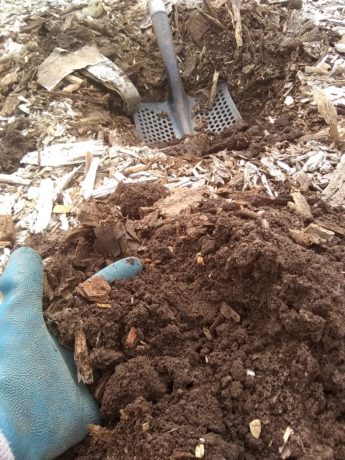 Two years ago friend sheet-mulched her very hard, dry dirt yard using cardboard and newspaper topped with very large chunk free wood chips. Last year into this were planted a scattering of California native plants. Most of them have thrived, even surviving a frost and many 100F + days. These have been minimally watered. This week in March, after very low seasonal rainfall, we set off to plant more natives. What we found under the mulch was amazing. That light brown dirt was now moist, worm-filled soil. Under what was left of the cardboard were beautiful fungal hyphae breaking down the under layer of bark chunks into a fine surface compost. The shovel slide through the newspaper and into the ground making for very easy digging.
Two years ago friend sheet-mulched her very hard, dry dirt yard using cardboard and newspaper topped with very large chunk free wood chips. Last year into this were planted a scattering of California native plants. Most of them have thrived, even surviving a frost and many 100F + days. These have been minimally watered. This week in March, after very low seasonal rainfall, we set off to plant more natives. What we found under the mulch was amazing. That light brown dirt was now moist, worm-filled soil. Under what was left of the cardboard were beautiful fungal hyphae breaking down the under layer of bark chunks into a fine surface compost. The shovel slide through the newspaper and into the ground making for very easy digging. 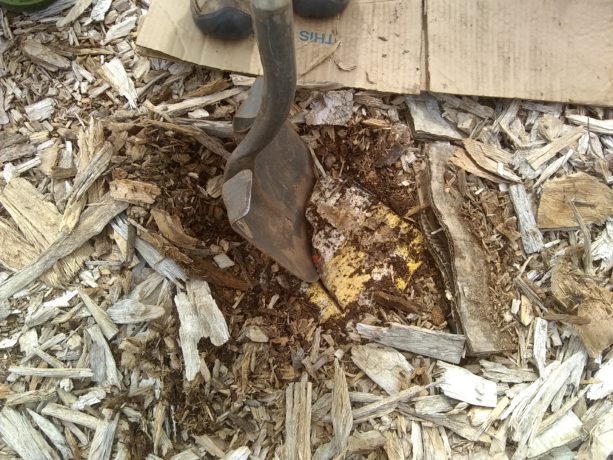 The soil smelled good and felt alive.
The soil smelled good and felt alive.Then we wanted to enlarge the planting area past the mulched area, and it was as if we were digging on another property. The shovel barely entered the dirt, and then hit hardpan within an inch of the surface. We had to chop and scrape holes to plant in. Once we did, we heavily sheet mulched around the plants.
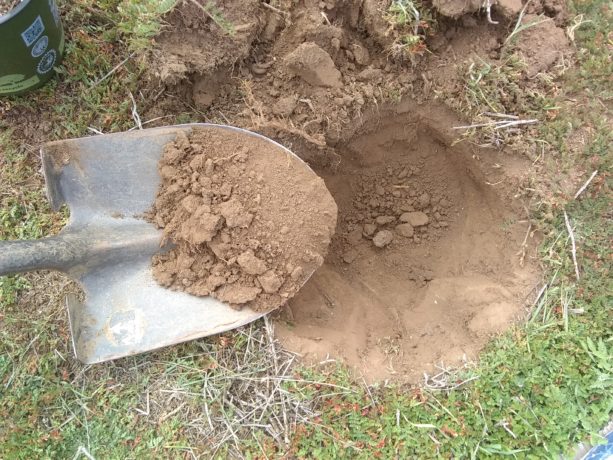
 Both of these areas, separated by a foot, have had the same rainfall and temperatures, but the mere existence of a thick layer of sheet mulch caused moisture and coolness to be retained, caused protection from hard rain, frost, high heat and dryness, compaction and wind. Just this easy combination of waste materials – wood chips and cardboard – made an incredible change in the soil structure and water retention.
Both of these areas, separated by a foot, have had the same rainfall and temperatures, but the mere existence of a thick layer of sheet mulch caused moisture and coolness to be retained, caused protection from hard rain, frost, high heat and dryness, compaction and wind. Just this easy combination of waste materials – wood chips and cardboard – made an incredible change in the soil structure and water retention.Last summer when the outside temperature was in the 90’s we dug into a pile of bark chips. On the top the wood was almost hot. Three inches down, it was cool and moist even though it hadn’t rained for months. A difference of night and day. This summer I’ll obtain a compost thermometer and take readings.
Leaving the soil bare is like going out in all weather unclothed. Your skin will burn and you’ll become dehydrated in summer; you’ll freeze and also become dehydrated in the cold. In heavy rain and hail you will try to protect yourself by becoming as small a target as possible. Although the soil isn’t cowering, it is being pounded down and de-oxygenated under the onslaught of weather. With no air in the topsoil water runs off rather than sinks in. Soil bakes and there is no microbial life in the desert of the uncovered topsoil. The soil freezes and frosts, and microbes are killed; the moisture in the soil evaporating with the coming of spring. All of this damage is preventable by the application of several layers of mulch, or sheet mulch. You wouldn’t think of being outside for a long time in harsh weather without clothing, so protect your soil the way nature intends, with a carpet of organic matter.
The cardboard had gone on top of weeds. No additives were used in planting, such as gypsum, fertilizer or compost. Watering is done on an as-needed basis with a hose. I am always thrilled and awe-struck when, over and over again, I see proof of what simple soil conservation efforts have on soil building.
California poppies seeds had been planted in the planting holes the year before, and their seeds have rooted in the bark mulch. Their roots will hold the mulch together and also help change it into soil, as poppies are colonizers helping repair disturbed soil. For the price of a packet of seeds, our friend now has the beginnings of a wildflower meadow filling out the spaces between native flowering plants.
Good soil begins the food chain, beginning from what science can so far tell from microscopic mycrobes and ending in this property at least perhaps at the nesting red tailed hawk in the nearest tree, or perhaps the largest local predator, the coyote. Meanwhile the butterflies and other native insects, and all the song birds, will be on display for our friend’s enjoyment.
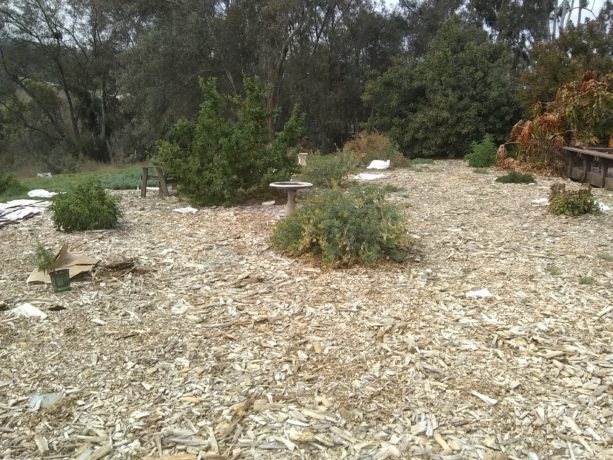
The sheet mulching will continue on over the slope, and as we plant we mix in pieces of old wood, we plant in shallow depressions in the ground to capture moisture and coolness, we dig a small fishscale swale above the plant to capture flowing water, and we sheet mulch heavily. It will be fascinating to keep checking that poor dirt as it regains microbial and fungal life simply through the protection of sheet mulch.
- Animals, Bees, Birding, Compost, Fungus and Mushrooms, Gardening adventures, Hugelkultur, Microbes and Fungi, Natives, Other Insects, Permaculture and Edible Forest Gardening Adventures, Predators, Quail, Rain Catching, Recycling and Repurposing, Reptiles and Amphibians, Soil, Water, Water Saving, Worms
Plant Guilds #2: Upper Canopy
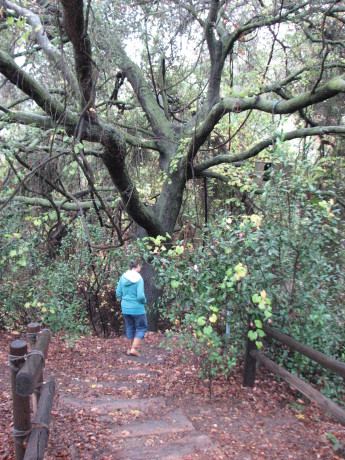
An oak is home to over 300 species. Not counting human. Whether you are planting small plants in pots, ornamentals in your yard or a food forest, you need plants that will provide an upper canopy for others. If you have small plants, then you will have a short canopy. Maybe your canopy is a tomato plant. Maybe its an oak. Whatever it is, canopy has many functions.
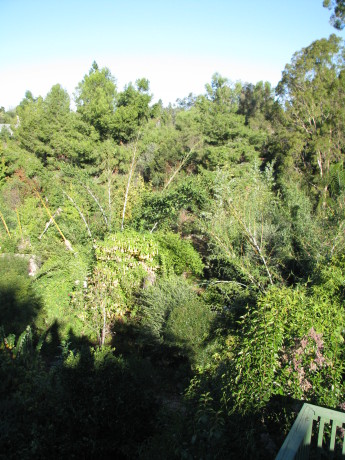
Upper canopy provides shade so that other plants can grow. It drops leaves, bark, flowers and seeds and/or fruit to provide compost and food for all levels of animals down to soil microbes. Canopy provides protective shelter for many kinds of mammals, birds, reptiles and insects as they hide under the leaves. A mature oak is home to over 300 species. Old scarred canopy full of holes is the natural home for honeybees, and many types of bird and other animal. It is a storage unit for acorns gathered by woodpeckers. Where you have animals, you have droppings. All the poo, feathers, regurgitated pellets, fur, scales and other organic waste that falls from canopy is vitally important for the health of the soil below.
Canopy provides a perch for raptors and larger birds that help with rodent control.
Canopy helps slow the wind; the fewer trees we have the harder the winds. Canopy also filters the wind, blocking dust and other debris. Canopy helps cool and moisturize the wind. The leaves of canopy trees help buffer the rain. Rain on bare ground is as compacting as driving over the dirt with a tractor. If rain hits leaves it bounces, rolls or shatters. Rain can then hit other layers below the canopy, finally rolling through leaf mulch to percolate into the soil without compacting it.
Canopy catches moisture as well. Here in Southern California we may not receive a lot of rain, but we do have moisture during the night.
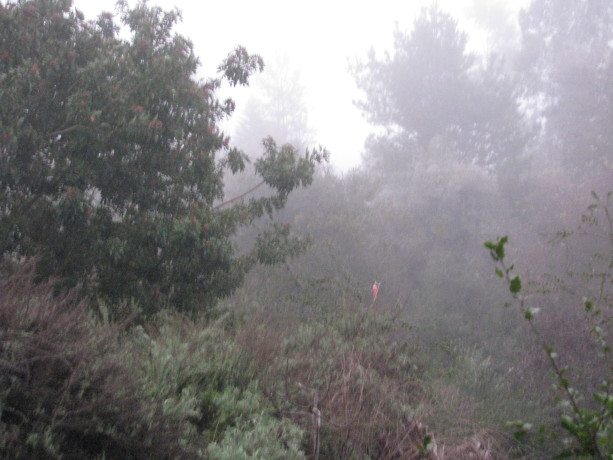 Often I’ve walked through Finch Frolic Garden of a morning to feed the hens, and the garden sounded as if it had its own special rain cloud over it. That is because moisture condenses on the leaves and rolls off. The more canopy and the higher the canopy, the more water we can collect. In that same way, canopy begins to hold humidity on the property, which the rest of the guild contributes to. Pollen dries out. With longer, hotter, drier summers there is worse pollination even if the pollinators are active, because the pollen isn’t viable. Less humidity equals fewer fruits, nuts and vegetables. Therefore, the more canopy, and other parts of a guild, the moister the air and the better the harvest.
Often I’ve walked through Finch Frolic Garden of a morning to feed the hens, and the garden sounded as if it had its own special rain cloud over it. That is because moisture condenses on the leaves and rolls off. The more canopy and the higher the canopy, the more water we can collect. In that same way, canopy begins to hold humidity on the property, which the rest of the guild contributes to. Pollen dries out. With longer, hotter, drier summers there is worse pollination even if the pollinators are active, because the pollen isn’t viable. Less humidity equals fewer fruits, nuts and vegetables. Therefore, the more canopy, and other parts of a guild, the moister the air and the better the harvest.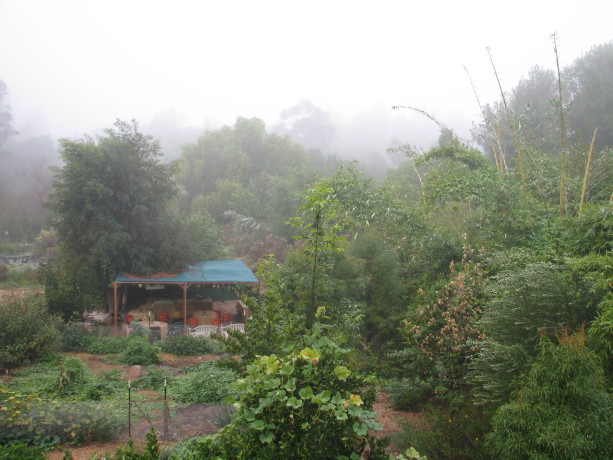
Canopy is in connection with all other plants in its community, linked via webs called mycorrhizal fungi. Through these webs the canopy sends chemical messages and nutrients to other plants. Every plant in the community benefits from the strong communications from the canopy trees.
Canopy builds soil. Canopy trees are large on top and equally large underground. Tree root growth can mirror the height and width of the above-ground part, and it can be larger. Therefore canopy trees and plants break through hard soil with their roots, opening oxygen, nutrient and moisture pathways that allow the roots of other plants passage, as well as for worms and other decomposers. As the roots die they become organic material deep in the soil – effortless hugelkultur; canopy is composting above and below the ground. Plants produce exudates through their roots – sugars, proteins and carbohydrates that attract and feed microbes. Plants change their exudates to attract and repel specific microbes, which make available different nutrients for the plant to take up. A soil sample taken in the same spot within a month’s time may be different due to the plant manipulating the microbes with exudates. Not only are these sticky substances organic materials that improve the soil, but they also help to bind loose soil together, repairing sandy soils or those of decomposed granite. The taller the canopy, the deeper and more extensive are the roots working to build break open or pull together dirt, add nutrients, feed and manage microbes, open oxygen and water channels, provide access for worms and other creatures that love to live near roots.
Canopy roots have different needs and therefore behave differently depending upon the species. Riparian plants search for water. If you have a standing water issue on your property, plant thirsty plants such as willow, fig, sycamore, elderberry or cottonwood. In nature, riparian trees help hold the rain in place, storing it in their massive trunks, blocking the current to slow flooding and erosion, spreading the water out across fields to slowly percolate into the ground, and turning the water into humidity through transpiration. The roots of thirsty plants are often invasive, so be sure they aren’t near structures, water lines, wells, septic systems or hardscape. Some canopy trees can’t survive with a lot of water, so the roots of those species won’t be destructive; they will flourish in dry and/or well-draining areas building soil and allowing water to collect underground.
In large agricultural tracts such as the Midwest and California’s Central Valley, the land is dropping dramatically as the aquifers are pumped dry. Right now in California the drop is about 2 inches a month. If the soil is sandy, it will again be able to hold rainwater, but without organic materials in the soil to keep it there the water will quickly flow away. If the soil is clay, those spaces that collapse are gone and no longer will act as aquifers… unless canopy trees are grown and allowed to age. Their root systems will again open up the ground and allow the soil to be receptive to water storage. Again, roots produce exudates, and roots swell up and die underground leaving wonderful food for beneficial fungi, microbes, worms and all those soil builders. The solution is the same for both clay and sandy soils – any soil, for that matter. Organic material needs to be established deep underground, and how best to do that than by growing trees?
In permaculture design, the largest canopy is often found in Zone 5, which is the native strip. In Zone 5 you can study what canopy provides, and use that information in the design of your garden.
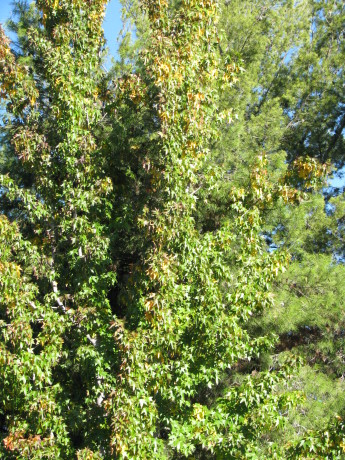 How do you achieve canopy in your garden? If your canopy is something that grows slowly, then you will need to nursery it in with a fast-growing, shorter-lived tree that can be cut and used as mulch when the desired canopy tree becomes well established. Some trees need to be sacrificial to insure the success of your target trees. For instance, we have a flame tree that was part of the original plantings of the garden. It is being shaded out by other trees and plants, and all things considered it doesn’t do enough for the garden to be occupying that space (everything in your garden should have at least three purposes). However a loquat seeded itself behind the flame tree, and the flame tree helped nursery it in. We love loquats, so the flame tree may come down and become buried mulch (hugelkultur), allowing that sunlight and nutrient load to become available for the loquat which is showing signs of stress due to lack of light. With our hotter, drier, longer summers, many fruit trees need canopy and nurse trees to help filter that intense heat and scorching sunlight. Plan your garden with canopy as the mainstay of your guild.
How do you achieve canopy in your garden? If your canopy is something that grows slowly, then you will need to nursery it in with a fast-growing, shorter-lived tree that can be cut and used as mulch when the desired canopy tree becomes well established. Some trees need to be sacrificial to insure the success of your target trees. For instance, we have a flame tree that was part of the original plantings of the garden. It is being shaded out by other trees and plants, and all things considered it doesn’t do enough for the garden to be occupying that space (everything in your garden should have at least three purposes). However a loquat seeded itself behind the flame tree, and the flame tree helped nursery it in. We love loquats, so the flame tree may come down and become buried mulch (hugelkultur), allowing that sunlight and nutrient load to become available for the loquat which is showing signs of stress due to lack of light. With our hotter, drier, longer summers, many fruit trees need canopy and nurse trees to help filter that intense heat and scorching sunlight. Plan your garden with canopy as the mainstay of your guild.Therefore a canopy plant isn’t in stasis. It is working above and below ground constantly repairing and improving. By planting canopy – especially canopy that is native to your area – you are installing a worker that is improving the earth, the air, the water, the diversity of wildlife and the success of your harvest.
Canopy is improving the water storage of the soil and increasing potential for aquifers. The more site-appropriate, native canopy we can provide in Zone 5, and the more useful a canopy tree as the center of a food guild, the better off everything is. All canopy asks for in payment is mulch to get it started.
Next week we’ll explore sub-canopy! Stay tuned! You can find the entire 9-part Plant Guild series here: Plant Guilds: What are they and how do they work? The first in a series. , Plant Guild #3: Sub-Canopy , Plant Guild #4: Nitrogen-Fixers, Plant Guild #5: Mining Plants, Plant Guild #6: Groundcovers, Plant Guild #7: Vines, Plant Guild #8: Insectiaries, Plant Guild #9: The Whole Picture.
- Animals, Bees, Birding, Compost, Gardening adventures, Health, Microbes and Fungi, Natives, Other Insects, Pets, Ponds, Predators, Quail, Rain Catching, Reptiles and Amphibians, Soil, Water, Water Saving, Worms
Why Buy Rain Barrels if you Own a Pool? Pool Conversion Discount!
Why buy rain barrels if you own a pool? You can collect about 20,000 gallons of rainwater in an average pool, and use it on your landscaping and for swimming if you don’t chlorinate it. If you have a pool or pond and put chemicals into it, or have a saltwater pool or one that is treated with UV light, you really need to read about how toxic those systems really are and how to change your pool into a swimmable, clean pond on PuraVidaAquatic.com. On that site is a host of great information about how bad mosquito fish are, how to make a truly healthy pond, why having a pond in a drought is a great idea and so very important, and so much more. If you live in Southern California and have a pool, you’ll be interested in this Fall Special:
- Animals, Bees, Birding, Compost, Fungus and Mushrooms, Gardening adventures, Health, Heirloom Plants, Microbes and Fungi, Natives, Other Insects, Perennial vegetables, Permaculture and Edible Forest Gardening Adventures, Pets, Ponds, Predators, Quail, Reptiles and Amphibians, Water, Water Saving, Worms
Permaculture and Pollinators lecture
- Animals, Bees, Birding, Building and Landscaping, Gardening adventures, Health, Microbes and Fungi, Natives, Other Insects, Permaculture and Edible Forest Gardening Adventures, Pets, Ponds, Predators, Quail, Rain Catching, Recycling and Repurposing, Reptiles and Amphibians, Water, Water Saving, Worms
Turn Your Pool Into a Pond, and Help Restore Wetlands!
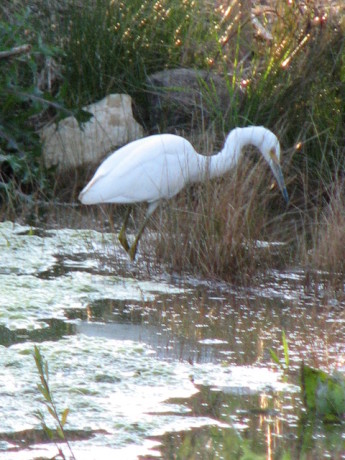
An egret on the hunt. Water birds now rely on flooded agricultural fields, which are saturated with herbicides and pesticides. It is estimated that 97% of California’s wetlands are gone. Gone. About two-thirds of that remaining 3% is dysfunctional and polluted. In Los Angeles, only 1% of wetlands remain. We have constructed our properties to drain precious rainwater and even irrigation water into culverts and out to the ocean, rather than collect it in our soil where it belongs. All the riparian animals, from specialized aquatic microbes and fungi up to large mammals, have gradually all but disappeared. What we have instead of wetlands are millions of chlorinated swimming pools, lined ponds and bird baths. Although we may believe that these help animals, the treated water is weakening and killing them with chemicals when they are desperate enough to drink from them, and offer no shelter or food source.
Dr. Bob Lloyd of Pura Vida Aquatics, a Southern California-based business, has spent the last 20 years maintaining ponds chemical-free. “Algicide will kill aquatic microbes, and hurt hummingbirds and all the other creatures that drink it,” he says. To help offset some of the loss of wetlands Dr. Lloyd converts swimming pools into swimming ponds that are cleaned with plants and fish rather than with chemicals.
You may see photos of some methods of pool conversions on the Internet that look fantastic, but really are expensive and drastic, and hard to maintain. They require the draining (and waste) of the 22,000 gallons (more or less) of pool water, the altering of the pool itself by building a cement planting bed along the inside and the filling of that bed with a large amount of gravel. Plants are set in the gravel and after refilling a pump sends water through this system to clean it. The gravel would need to be cleaned over time, which would mean draining water again and hauling out a ton of slimy gravel, and buying new.
Dr. Lloyd’s system is far less expensive, not invasive to the pool structure at all and is easily removable if years down the road the system is no longer desired. His system is unique and is the product of his PhD in microbiology and his decades of experience working with natural ponds. The plants that are installed are outside of the pool and can have a look that goes with the surrounding vegetation. Even aquatic edibles can be experimented with, such as watercress, water chestnuts and more.
Installing plants inside a pool can be done without changing the pool structure if the pool isn’t going to be used for swimming, or only for gentle laps. The reason is that the splashing water and waves from vigorous swimming is very hard on plants. Many plants die from having too much water on their leaves, and from being battered against the sides of the pool. Using Dr. Lloyd’s method of external decorative plants the pool has the ambiance of a pond and the usability of a regular swimming pool. And you can still swim with koi and other fish! How cool is that?
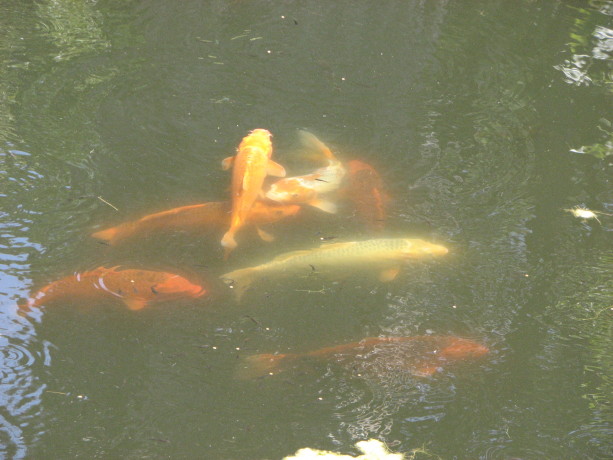 Converting your pool or pond takes a little patience as the biology develops; do you remember the adage that you can’t rush Mother Nature? The evolution of a pool conversion lasts several months. Watching the evolution of a chemical pool to a swimming pond is exciting. With the absence of chlorine, there is a natural algae bloom which turns the inside of the pool a bright, beautiful green. The algae help clear the water of harmful chemicals. As the water is routed through plants, some of the aquatic creatures that balance a pond are added from a local source. As the water clears, fish are added. The fish eat the algae so there are no fuzzy green threads growing up from the bottom or floating on the surface. Fish can be added within weeks of the start of the project. “Its like managing a 20,000 gallon fishtank,” Dr. Lloyd grins.
Converting your pool or pond takes a little patience as the biology develops; do you remember the adage that you can’t rush Mother Nature? The evolution of a pool conversion lasts several months. Watching the evolution of a chemical pool to a swimming pond is exciting. With the absence of chlorine, there is a natural algae bloom which turns the inside of the pool a bright, beautiful green. The algae help clear the water of harmful chemicals. As the water is routed through plants, some of the aquatic creatures that balance a pond are added from a local source. As the water clears, fish are added. The fish eat the algae so there are no fuzzy green threads growing up from the bottom or floating on the surface. Fish can be added within weeks of the start of the project. “Its like managing a 20,000 gallon fishtank,” Dr. Lloyd grins.Immediately the changes to the environment are apparent. Dragonflies, butterflies, hummingbirds and many more creatures desperate for truly clean (chemical-free) water are attracted to the water and the plants.

A hummingbird coming in for a drink in one of Dr. Lloyd’s newly chemical-free ponds. “I have clients who tell me how excited they are to see so many birds, insects and lizards in their yards that they’d never seen before,” Dr. Lloyd relates about his converted ponds. “Finding (native) Pacific chorus frogs around the ponds has been very fun.” Some of his clients have become active bird watchers as the wildlife come to ponds that he manages.
Best of all, you can swim with the fish and have no red eyes, green hair or other bad reactions to the harsh chemicals. The plants phytoremediate the water as it is pumped through the planting beds. Children can dangle their feet in the pond without fear of absorbing algicide and other harsh chemicals through their skin.
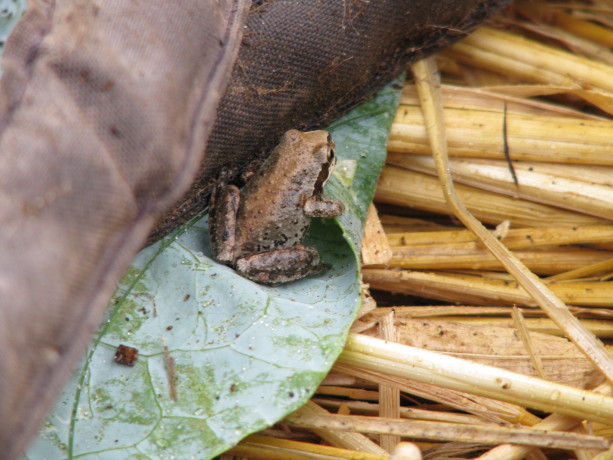
Pacific Chorus frogs are native and disappearing. They live in your garden during the year and eat insects. Because we are in a drought, people believe that drying out their pond or pool is necessary. No! Pools evaporate far less water than irrigated lawns and landscapes. What does evaporate helps hold humidity around your plants, something which our drying climate is eliminating. Humidity keeps pollen viable and helps trees and plants survive the lack of rainfall. If you convert your pool and/or pond to a chemical-free one, then it is now supplying habitat to creatures further taxed by dried-up water supplies. What’s more, your pool which isn’t attractive and is rarely used, which must be doctored with chemicals weekly, can be converted into something that benefits wildlife year-round, is interesting to watch all the time, and needs absolutely no chemicals.
Pools are also excellent catchment basins for rain. Instead of buying a large water tank, divert your roof water to your pool and allow the plants to clean it. Then you can use that water at any time during the year for watering plants – with chlorine- and chloramine-free water. In permaculture, everything should have at least three purposes. By converting your pool you can have a free rain-catchment system, a water cleaning system, a safe recreation area, a pleasing view, and some habitat, all while saving money and reducing your carbon footprint and reducing your water bill. How can you not do it?
A converted pool does require weekly maintenance, but not the usual kind with chemicals and cleaners. I remember having to clean the family’s pool when I was growing up and testing the pH, even though we didn’t swim very often. It wasn’t fun. The maintenance on a chemical-free pond consists of checking on the pump, the caring for the plants and fish, and insuring that the clarity of the water and the product is satisfying to the customer. The ecosystem evolves and must be watched. It also costs a fraction of what a pool cleaner charges.
If you have a pond or pool that is on a chemical system, consider a conversion. You’ll spend far less money, have far more entertainment, decorative and educational value, have safe water for your family and wildlife to enjoy, will be helping the environment by not supporting harmful chemicals and by helping off-set the millions of acres of wetlands that are gone.
Dr. Lloyd estimates that he’ll need to convert 1.6 billion swimming pools to offset all the wetlands that have been drained and paved over in California alone. How can it be done?
“One pool at a time,” he smiles.
You can find out about pool and pond conversions by contacting Dr. Bob Lloyd at Pura Vida Aquatics, 310- 429- 8477 http://www.PuraVidaAquatic.com. He has accounts from San Diego through Los Angeles, and can consult elsewhere.
- Animals, Bees, Birding, Building and Landscaping, Chickens, Compost, Fungus and Mushrooms, Gardening adventures, Heirloom Plants, Hugelkultur, Microbes and Fungi, Natives, Other Insects, Perennial vegetables, Permaculture and Edible Forest Gardening Adventures, Pets, Ponds, Predators, Quail, Rain Catching, Recycling and Repurposing, Seeds, Soil, Special Events, Water, Water Saving, Worms
Water Harvesting With Simple Earthworks
Finch Frolic Garden’s Program In The Garden Series for June:
Shaping the land to harvest energy and water – easily!
With permaculturalist Jacob Hatch of Hatch Aquatics and Landscaping
Use 30% – 70% less water on your landscape!
Jacob Hatch of Hatch Aquatics will show you how to catch free, precious, neutral pH rainwater using earthworks. Whether you use a trowel or a tractor, you can harvest that free water. Each attendee will receive a plant! We will, of course, offer homemade vegetarian refreshments. Cost is $25 per person, mailed ahead of time. Finch Frolic Garden is located at 390 Vista del Indio, Fallbrook. Please RSVP to dianeckennedy@prodigy.net . More information can be found at www.vegetariat.com. You’ll love what you learn!
- Animals, Bees, Birding, Building and Landscaping, Gardening adventures, Hugelkultur, Microbes and Fungi, Natives, Other Insects, Pets, Predators, Quail, Rain Catching, Reptiles and Amphibians, Water, Water Saving, Worms
Artificial Turf? Big Mistake.
Want a green lawn that needs no irrigation or mowing? That sounds ideal. As with most products that sound too good to be true, so it is with artificial turf. Modern artificial turf is not much like the Astroturf of old. Artificial grass blades are usually made of polyethylene, polypropylene or nylon, which create soft, harder or stiff blades respectively. These are anchored in an infill material that is usually a mixture of sand and ground up recycled automobile tires among other things. Utilizing recycled tires should give this product big bonus points; however, this material will leach heavy metals into the ground, contaminating the dirt for decades. When heated, the plastic and rubber will release toxins into the air as well.
Heat is the biggest problem with artificial turf, according to King Green. The infill made of plastic and rubber is a thermal mass: as it sits in the sun it absorbs and radiates heat. For example, at 6 pm, an hour before the Women’s World Cup in Canada began at the end of a nice 75 degree day, the artificial turf on which they were to play measured 120F. Where daytime temperatures rise to 100F, the turf could measure up to 180F. Having turf where children or animals play can cause burns.
Radiating heat from thermal mass such as hardscape (usually cements and asphalt), expanses of gravel, and especially artificial turf will heat up homes and is a contributor to more energy usage for air conditioners and fans. In arid areas there might not be much rainfall but there can be fog and ambient moisture that normally collects on leaves and drips as a form of irrigation. Good pollenization partially depends upon moist, still air because pollen dries rapidly. Radiating heat and reflected light (the albeido effect) from these surfaces help to dry out moist air and cause air movement as the heat rises. The more rising heat, the windier and drier the atmosphere becomes and the less fruit and vegetable set there is. As artificial turf heats up to a third again of the atmospheric temperature and continues to radiate into the evening it is even more damaging to atmospheric moisture than bright cement.
The claim that artificial turf greatly reduces the amount of toxins in the air that would be released from lawnmowers, and save thousands of gallons of water otherwise used to irrigate lawns is using select ideas while ignoring others. Artificial turf may not need mowing, but it needs leaf-vacuuming and hosing off, especially if there are animals using it. On soil bird, reptile and pet feces are part of the fertilization process and are quickly decomposed by microbes. On artificial turf the feces adhere to the plastic blades and are difficult to remove with even a power wash. Urine seeps into the rubber matting and cannot be completely removed, smelling strongly of urine for the life of the turf.
Native plants and grasses improve the soil, hold rainwater, moderate heat and wind, and offer habitat for hundreds of birds, mammals and insects. Areas that are covered in artificial turf are sterile, harmful to animals, people and the environment, and offer no educational value. Planted areas are magnets for wildlife that are starved – literally – for decent food, water and shelter.
The life of some artificial turf products is estimated to be 10 – 15 years, with a warranty usually for 8. If the grass is being heavily used the life is reduced. The turf doesn’t look new up until the warranty expires; the blades break off and the plastic and rubber slowly break down further been compressed, dried out and imbued with heavy metals.
The cost of installing artificial turf is heavy. It must be laid on scraped, level, rockless dirt, so there are earthworks involved. There are many types of artificial turf and they have a broad price range. A 12’ x 75’ strip of low-grade turf from a chain hardware store is currently over $1500.
What are the alternatives in this time of water scarcity? For areas that must have grass, tough native grass mixtures are a great alternative. See the selection that S&S Seeds has of native Californian grasses; they even offer sod. Lawns should be mowed higher and more frequently for best root growth, and the cuttings left to mulch in. For least evaporation and for pathogen control watering should be done between 3 AM and 9 AM. See this site for more lawn tips.
Stop using commercial fertilizers, which cause plants to need more water. Use actively aerated compost tea, which is easy and inexpensive to make, completely non-toxic and causes deeper root growth and therefore healthier, longer-lived and more resilient grass. Please explore the work of Dr. Elaine Ingham, soil microbiologist, who has perfected the use of AACT on properties worldwide. Instructions for making AACT can be found here.
For those who don’t need a lawn at all, native landscapes can be lush and beautiful and after being established dislike summer water. You can see what native and non-native plants are safe to plant near your house if you live in a fire zone with the County of San Diego’s Defensible Space Plant List. Please see the books The California Native Landscape by Greg Rubin and Lucy Warren, and California Native Plants for The Garden by Bornstein, Fross and O’Brien.
The secret to water storage in the soil for both lawns and plants is to dig in as much organic matter into the soil that you can. Artificial turf is also not permeable, so it channels rainwater rather than harvesting it. Old wood is best, but cuttings, organic fabric and paper can all be used to hold rainwater. One inch of rain on one acre in one hour is 27,154 gallons of water. The best place to hold that water for your plants –or to hold precious irrigation water – is in the soil. Wood in the soil along with top mulch will water and feed plants for months, as well as cleanse and build soil. This practice is called hugelkultur. Please research hugelkultur on the Internet for more information.
If you are considering purchasing artificial turf or gravel for your yard or common area, please think again. It is adding to the problem of global warming, it is an elimination of even more habitat – even the scarce habitat that a lawn can offer – and will become an expensive problem in a short time.
- Animals, Bees, Birding, Gardening adventures, Other Insects, Ponds, Predators, Quail, Reptiles and Amphibians
The Uninvited Guest: Living With Wildlife
The Uninvited Guest: Living With Wildlife
Finch Frolic Garden’s Program in the Garden Series
Sunday, May 24 2-4 pm
Miranda Kennedy (B.S. Fisheries and Wildlife Science) brings a naturalist’s enthusiasm and a scientist’s perspective to the topic of wildlife vs. domesticated land.
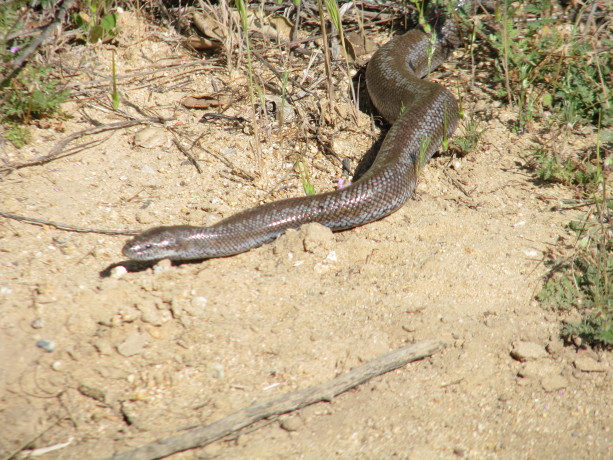 In this fun informal talk, Miranda will give insight into the ecology of many of our wonderful Southern California native wildlife species, focusing on the issues of the human-wildlife interface such as land management, garden damage, disease, domestic animals, pollinators, and the conservation concern. The talk and discussion will explore methods for peaceful and mutually beneficial cohabitation of this precious resource necessary to human and wildlife alike: habitat.
In this fun informal talk, Miranda will give insight into the ecology of many of our wonderful Southern California native wildlife species, focusing on the issues of the human-wildlife interface such as land management, garden damage, disease, domestic animals, pollinators, and the conservation concern. The talk and discussion will explore methods for peaceful and mutually beneficial cohabitation of this precious resource necessary to human and wildlife alike: habitat. Each attendee will receive a native pollinator-attracting plant! We will, of course, offer homemade vegetarian refreshments.
Cost is $25 per person. Finch Frolic Garden is located at 390 Vista del Indio, Fallbrook. Please RSVP to dianeckennedy@prodigy.net . More information can be found at www.vegetariat.com.

